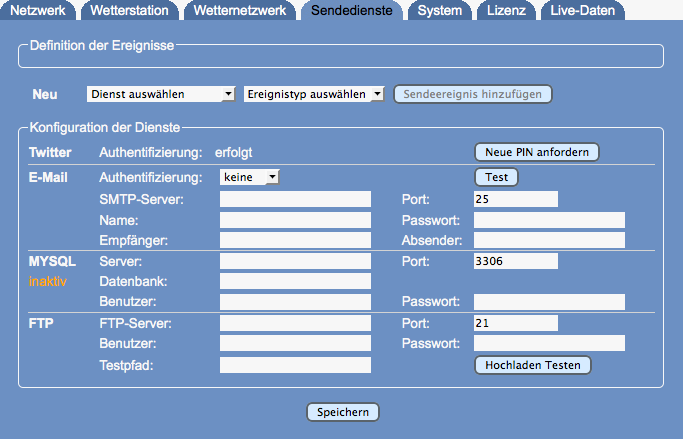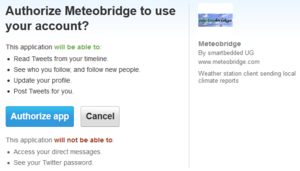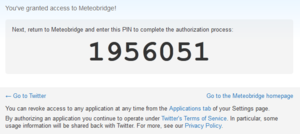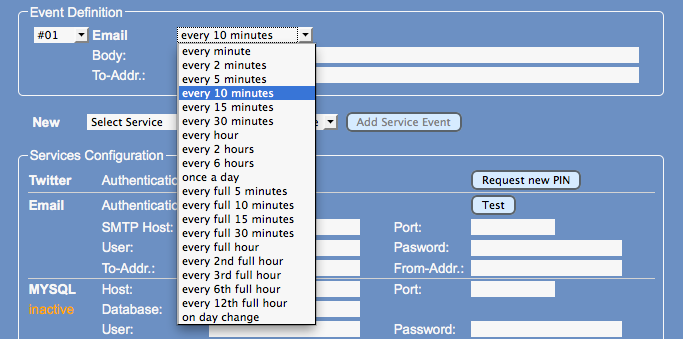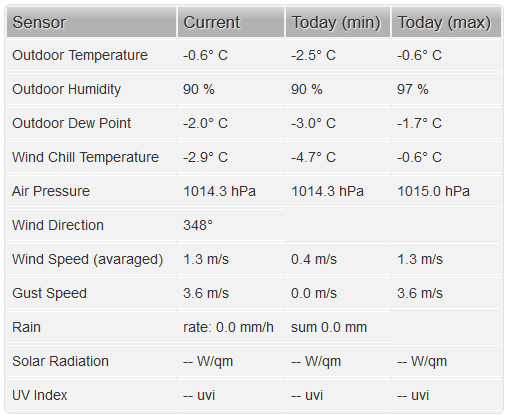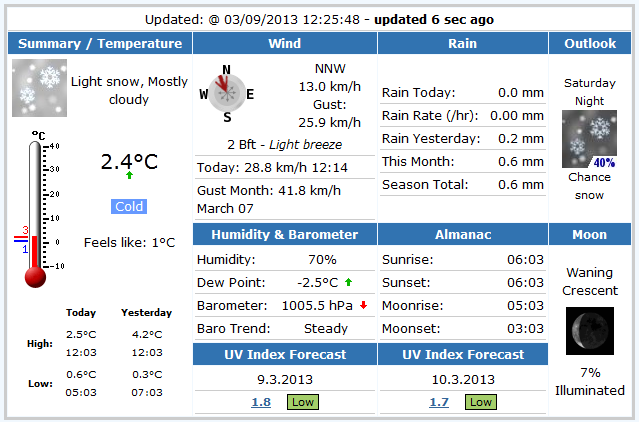Sendedienste
Meteobridge stellt eine Reihe von individualisierbaren Sendedienste zur Verfügung, die auf verschiedene Arten Wetterdaten an andere Systeme per E-Mail, Twitter, HTTP-Anfragen, FTP-Uploads, MYSQL-Befehle oder durch die lokale Ausführung von Skripten weiterleiten können. All diese Dienste können zu festen Zeitpunkten, in regelmäßigen Intervallen, die von wenigen Sekunden über Minuten bis hin zu Stunden definiert sind, oder durch das Eintreten von Alarmbedingungen ausgelöst werden.
Die Konfiguration der Sendedienste erfolgt in zwei Schritten.
- Wenn an E-Mail, Twitter, MYSQL oder FTP verwenden möchte, müssen zunächst entsprechende Athetifizierungen durchgeführt werden, damit diese Dienste genutzt werden können.
- Anschliessend können spezifische Sendeereignisse definiert werden, die sich dieser vorkonfigurieten Sendedienste bedienen.
Wenn man erstmalig auf diesen Reiter geht, sind noch keine Ereignisse definiert und die Sendedienste erwarten die notwendigen Konfigurationseingaben.
Konfiguration der Sendedienste
Die Sendedienste Twitter, E-Mail, MYSQL und FTP erfordern eine initiale Konfiguration bevor Eregisse definiert werden können.
Meteobridge ermöglicht Wetterdaten an Twitter zu senden. Dazu muss die Meteobridge sich zunächst gegenüber Twitter authentifizieren. Dies erfolgt in 5 Schritten:
1. Die Taste "PIN anfordern" drücken
2. In dem neu erscheinenden Fenster muss dem man sich mit seinem Twitter-Account anmelden
3. Dort anmelden und die von Twitter bereitgestellte PIN kopieren
4. PIN in das Feld neben "PIN Aktivieren" eingeben und den Knopf drücken
5. Wenn die PIN akzeptiert wurde, erscheint der Hinweis "Authentifikation: erfolgreich"
Meteobridge ist nun bereit, ereignisgesteuert Nachrichten an Twitter zu senden.
Sending E-mails
Meteobridge can largely customizable e-mails. To get this service initialized you have to work through the following settings:
- Authentication: This drop-down box allows you to define the authentication mode used with the SMTP server. You can choose between:
- none: This setting does not send any authentication information to the SMTP server. Only servers in closed LANs will provide that (if at all).
- basic: Old-fashioned user name and password authentication, without SSL encryption
- tls: authentication with SSL encryption (a variant not used very often)
- starttls: standard authentication with SSL encryption (most often used)
- SMTP Host: specifies the IP or name of the SMTP server to use.
- Port: port number where SMTP server listens for mails (standard ports are 25 for non-SSL and 587 for SSL communication)
- User: user name to be used for authentication
- Password: password to be used
- To-Addr.: E-mail address of the recipient
- From-Addr.: E-mail address of the sender (many SMTP servers only accept mails with a sender address being in the same domain as the SMTP server itself)
Pressing the "Test" button sends an e-mail with subject "Meteobridge Test" to the given address. If sending the mail does not work, an error message will pop-up, trying to explain what went wrong.
MYSQL Uploads
When you prefer to store your weather station's data in your own MYSQL database, Meteobridge can feed sensor data to it in a very easy way. In order to support MYSQL queries some genric data must be specified.
- Host: server name or IP of server (when DNS can't resolve the name)
- Port: port number where to reach MYSQL database on your server
- Database: name of database to feed
- User: name of database user to use for data upload
- Password: password for user name.
When mysql service is not defined and not used bx events, Meteobridge removes the storage intensive mysql libraries during boot. This is indicated by the orange "inactive" sticker. You can still define the mysql server credentials, but it will need an event definition making use of mysql saved and then the Meteobridge rebooted to get the mysql libraries ready for operation.
FTP Uploads
Meteobridge allows you define a FTP server that can be bu used for uploading files. Meteobridge can just handle one FTP server, but you can define distinct directories and file names for each upload event later on. Setup of generic FTP upload credentials is done as follows:
- FTP Host: server name or IP of server (when DNS can't resolve the name)
- Port: port number where to reach MYSQL database on your server
- FTP User: user name to be used for FTP upload
- FTP Password: password to be used for FTP upload
In order to check if FTP credentials do work, you can press "Test Upload" button. Meteobridge will upload a file named "test-upload" with current time stamp as content to your FTP server. File will be located at directory that is default when doing FTP login. When you want to test upload to different directories you can specify an path in "Test Path" field. This path is used for test uploads only.
Definition Of Events
Meteobridge allows you to define up to 20 events that make use of push services. You have defined events listed at the top of the tab.
Adding an event is extremely easy. Just pull down the "Select Service" selector and choose the service type you want to use.
Next choose the type of event you want to define and then you press "Add Service Event" button.
Having done that a new service event will be added to the list of events and you can specify details of this specific event. Each event definition consists of a section where the trigger conditions are specified and a section that defines the payload the event is expected to transport via the service underneath.
Event Types
There are three event types to choose from that can be applied to all push services Meteobridge provides.
Periodical
This allows you to define the interval the event will be triggered. For some services it goes down to every 5 seconds and for the rest it is in the range of minutes up to hours. You simply select the repeating interval by a drop-down list.
Specific Time
Here you can define the time of day when the event has to be triggered. Time can be selected from a drop-down list in 15 minute steps.
Alarm Conditions
This allows you to specify the alarm trigger mode and conditions used for raising and clearing the alarm.
You can choose between "One-Time Alarms" which are triggered once and need to be cleared before they can fire again, and "Incremental Alarms" which allow a re-triggering of a non-cleared alarm, when the triggering event matches "raise condition" by a larger magnitude than the last trigger event.
- Raise Condition: defines the condition to be met in order to fire an alarm. Once an alarm is fired, it will not be fired again until the alarm is cleared again. When you have selected incremental alarms, an alarm can be fired again under certain circumstances. Details on condition statements are explained in "conditions" subsection below.
- Clear Condition: defines the condition to be met to clear a fired alarm. Details on condition statements are explained in "Alarm Conditions" subsection below.
There are two type of conditions that are formulated exactly the same way, but have different meaning. If a "raise condition" is satisfied, the related event service will be triggered. To trigger the services event again, it needs the "clear condition" to be satisfied first. The idea behind that is to suppress a large amount of follow-up event evocations on an event already given attention. For example, when raise condition is set to "outdoor temp at least 35°C" and clear condition is set to "outdoor temp below 30 °C" and resolution used for comparison is integer level (zero decimals) you will get a message once the temperature reaches 35° but will not get additional messages on that until the temperature has dropped below 30°C again. When you have selected "incremental alarms" and temperature raises from 34°C up to 37.2°C you will get one messages about reaching 35°C, one about reaching 36° and one about reaching 37°C threshold. This gives you the chance to notice how much the given threshold was passed.
There are two types of condition expressions. The simple one is just comparing two numbers, the complex variant allows for full arithmetic expressions.
Simple Condition Expression
In this case the expression consists of three parts separated by blanks.
- First part is the variable. Variables in conditions are exactly the same as in Meteobridge Templates, so you don't have to learn a new syntax here. While variables in templates are embedded into a pair of square brackets, variables in condition statements don't have that brackets. A raise condition like wind0wind-act=kmh.1:0 > 35 makes use of variable definition "wind0wind-act=kmh.1:0", which stands for actual non averaged wind speed, converted to km/h with no decimals and when there is no sensor data there, then 0 is taken as speed.
- Second part is a comparison operator. Defined operators are
- = equal, != non equal
- < less than, <= less than or equal
- > greater than, >= greater than or equal
- Third part is a numerical value, which can be integer or float.
Examples:
- wind0wind-act=kmh.1:0 > 10 triggers when current, non-averaged wind speed exceeds 10 km/h
- th0temp-act=c.1:0 < 0 triggers when outdoor temp goes below 0°C
Complex Condition Expression
Complex expressions can make use multiple operators and brackets. Weather data can be used in terms of Meteobridge variables as explained in Templates section. Variables need to be in full template-like notation, including the surrounding square brackets. Defined operators are:
| Operator | Description |
|---|---|
| &&, || | logical "and", "or" operators working on value range: 1=true, 0=false |
| ==, !=, >, >=, <, <= | comparison operations working on value range: 1=true, 0=false |
| +, - | arithmetic operators "plus" and "minus" |
| *, / | arithmetic operators "multiply" and "divide" |
| ^ | arithmetic operator "power" |
Result of the expression is interpreted as a boolean. Values above zero are regarded "true", values below or equal zero are regarded "false". When "incremental alarm" is specified, Meteobridge compares new value with former value and does trigger an alarm, when new value is bigger then the one that has triggered an alarm before.
Examples:
- [rain0total-sumday=mm:0] - 10
triggers an alarm when todays rain exceeds 10mm. When alarm mode is set to "incremental alarm", every time rain increases above 10mm, a new alarm will be triggered. This happens because the expression does not return a boolean, but a value that regarded "true" when result is above zero (here, 10mm rain fall). Further increases will keep the condition "true" but will also increment the number and therefore, will fire additional alarms. - [wind0wind-act=kmh.1:0] > 20 && ([wind0dir-act:180] >= 315 || [wind0dir-act:180] <= 45)
triggers an alarm when non-averaged wind speed is more than 20 km/h and wind direction is mainly North (NW-NNW-N-NNE-NE).
Event Deletion
Getting rid of a defined event definition is simply done by pulling down the select box in front of the event definition and to press "save" after that.
Twitter Event
When you define a twitter event you just have to fill the "text message" with the message to be posted. Text message can make full use of Meteobridge template variables. The example below sends out a twitter message every day at noon that contains outdoor temperature in degrees Celsius.
Email Event
When you define an email event you have the fill the mandatory email body text field. If the optional "Addr.-To" field is left blank, then the email address from the email service definition at the bottom of the tab is used as default.
In the example above every hour an email is sent out with a subject like "weather at 11:23" and a body text like shown below. Please notice that the "#" symbol divides subject from body text.temp 12.3°C gust 6.7kmh
FTP Event
Data to be uploaded via FTP cannot be stored on the Meteobridge as it does not provide the necessary persistent storage capacity. Therefore the templates to be filled with weather data have to reside on a server where Meteobridge can request it from by an URL. When the template URL is specified you have to press "Reload Template" to store the current version of the template into the RAM of the Meteobridge for further use. Beside the URL to the template you also have to define a path that defines to which folder of the FTP server the filled template should be uploaded to.
FTP Dashboard Example
Example above makes use of a pre-defined dashboard html file and fills it every 10 minutes with recent weather data and uploads it as file name "/public_html/dashboard.html" to the specified FTP server. The file "dashboard.html" is a simple HTML file with some Meteobridge weather variables included. When you view "dashboard.html" with your browser it looks like this:
Details of using variables in templates are explained in Templates section. To illustrate that using these variables is quite easy the HTML body part (omitting the CSS styles for formatting it nicely) of the template of above's example is attached below:
<body>
<table id="table-2">
<thead><tr><th>Sensor</th>
<th>Current</th>
<th>Today (min)</th>
<th>Today (max)</th></tr></thead>
<tbody>
<tr><td>Outdoor Temperature</td>
<td>[th0temp-act.1:--]° C</td>
<td>[th0temp-dmin.1:--]° C</td>
<td>[th0temp-dmax.1:--]° C</td></tr>
<tr><td>Outdoor Humidity</td>
<td>[th0hum-act.0:--] %</td>
<td>[th0hum-dmin.0:--] %</td>
<td>[th0hum-dmax.0:--] %</td></tr>
<tr><td>Outdoor Dew Point</td>
<td>[th0dew-act.1:--]° C</td>
<td>[th0dew-dmin.1:--]° C</td>
<td>[th0dew-dmax.1:--]° C</td></tr>
<tr><td>Wind Chill Temperature</td>
<td>[wind0chill-act.1:--]° C</td>
<td>[wind0chill-dmin.1:--]° C</td>
<td>[wind0chill-dmax.1:--]° C</td></tr>
<tr><td>Air Pressure</td>
<td>[thb0seapress-act.1:--] hPa</td>
<td>[thb0seapress-dmin.1:--] hPa</td>
<td>[thb0seapress-dmax.1:--] hPa</td></tr>
<tr><td>Wind Direction</td>
<td>[wind0dir-act.0:--]°</td>
<td></td><td></td></tr>
<tr><td>Wind Speed (averaged)</td>
<td>[wind0avgwind-act.1:--] m/s</td>
<td>[wind0avgwind-dmin.1:--] m/s</td>
<td>[wind0avgwind-dmax.1:--] m/s</td></tr>
<tr><td>Gust Speed</td>
<td>[wind0wind-max5.1:--] m/s</td>
<td>[wind0wind-dmin.1:--] m/s</td>
<td>[wind0wind-dmax.1:--] m/s</td></tr>
<tr><td>Rain</td>
<td>rate: [rain0rate-act.1:--] mm/h</td>
<td>sum [rain0total-sumday.1:--] mm</td>
<td></td></tr>
<tr><td>Solar Radiation</td>
<td>[sol0rad-act.0:--] W/qm</td>
<td>[sol0rad-dmin.0:--] W/qm</td>
<td>[sol0rad-dmax.0:--] W/qm</td></tr>
<tr><td>UV Index</td>
<td>[uv0index-act.1:--] uvi</td>
<td>[uv0index-dmin.1:--] uvi</td>
<td>[uv0index-dmax.1:--] uvi</td></tr>
</tbody>
</table>
</body>
Saratoga Template Example
Meteobridge is supported by the well-known Saratoga templates, which allow you to easily build your own powerful weather homepage. Procedure how to install the php scripts and how to configure Meteobridge's FTP upload is described in detail here.
When having done the well explained and easy to do setup, your website will look like this:
FTP Camera Event
If Meteobridge drags pictures from a web cam or an Ubiquiti AirCam these pictures can also be uploaded via FTP. Here you just have to define the target path and file name, which can include date and time variables as specified by "strftime" GNU C function.
Example above stores a web cam picture every ten minutes and gives it a file name reflecting date and time like "2014-06-23_12:34_weatherpic.jpg". Details about "strftime" syntax can be found here.
HTTP Event
Meteobridge can send HTTP GET requests containing weather data as URL parameter. This can be used to feed individual weather networks. Beside the mandatory URL you can optionally define a success string that is matched against the data the requested web server returns to the Meteobridge.
- When the success string is empty, no checking against the returned data is done
- If the success string is not empty the returned data is analyzed and if the given success string is found in the returned data the transmission is expected to be successful, otherwise an Error is signaled.
- If the success string starts with an exclamation mark "!" the transmission is regarded successful when the string is not found in the returned data.
In the example above Meteobridge sends recent wind speed every 15 seconds to the specified server and assumes transmission went fine, when returned data does not include the string "Error".
MYSQL Event
Meteobridge can send queries to a mysql server, which can be used to register weather data into a regular database. The mandatory query text field will usually contain a mysql insert statement followed by a table name and a list of column names and values. The query is subject to template replacement, so you can use Meteobridge variables to upload weather data to your database.
In the example above Meteobridge sends recent temperature and average wind speed every 10 minutes to a mysql database.
Script Execution Event
Meteoridge can download executable shell scripts from an URL and can execute these scripts. When you define a new event of this type, please lead the script by the "Reload Script" button before trying to execute the script. The parameter text field is optional, in case the script can handle additional parameters. The documentation string is derived from the loaded script and just displays the first line of the script containing a "###" pattern.
Settings above define to trigger script stored at "http://templates.meteobridge.com/reboot.sh" every day at 23:45. There are no parameters to be handed over to the script. The script provides a one-line documentation, which is marked in the script by three leading '#'. As you can see the script below does mainly issue a "reboot" of the Meteobridge.
#!/bin/sh # ### reboot Meteobridge; no parms reboot exit 0
